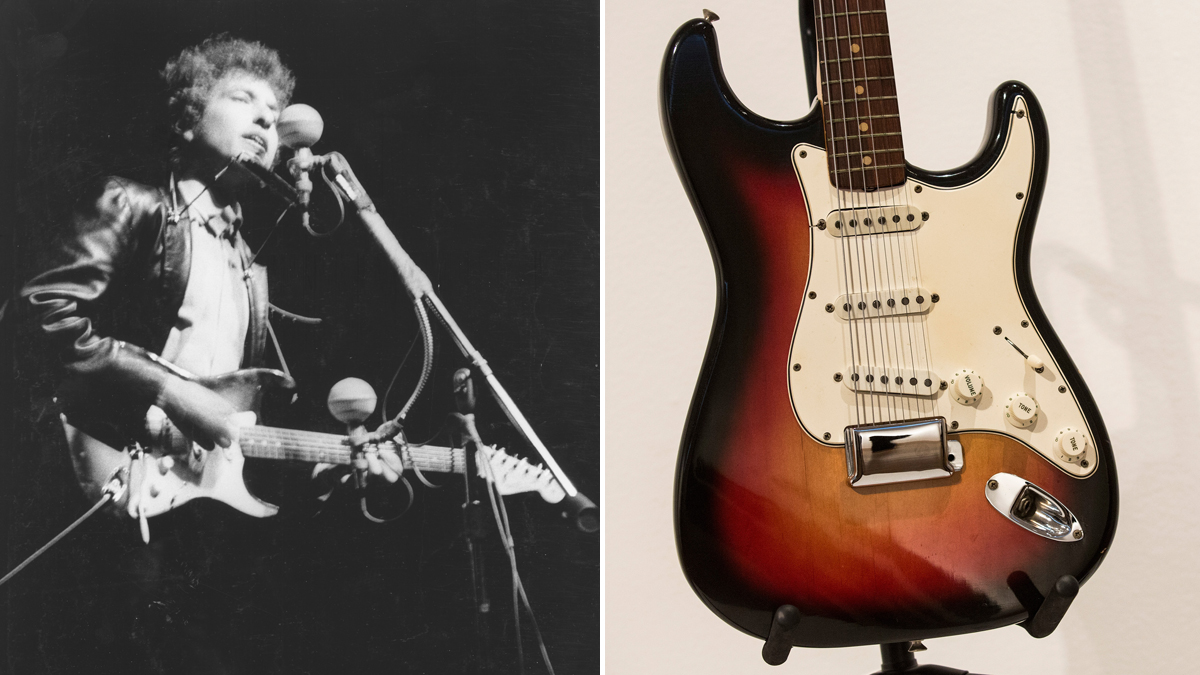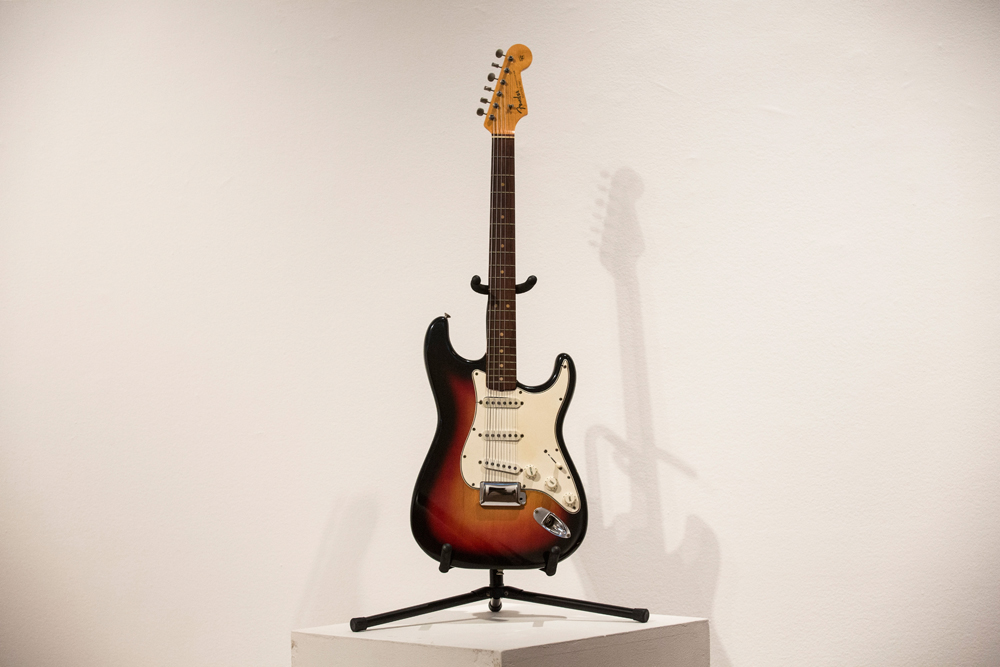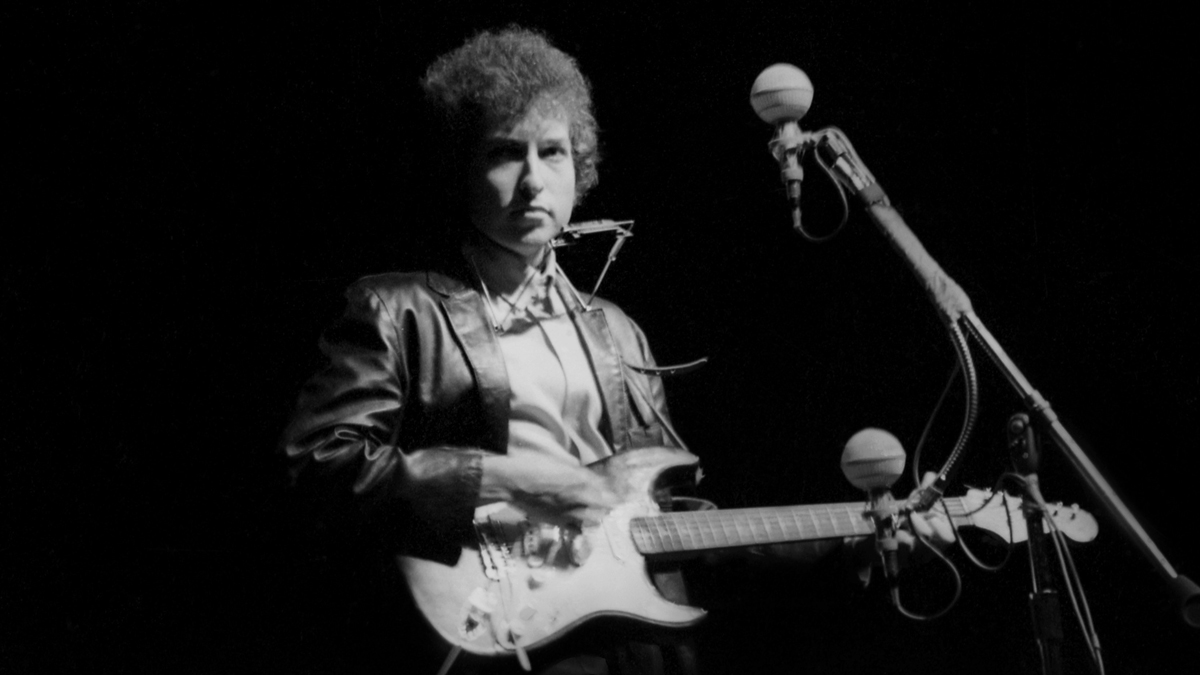How Bob Dylan’s infamous Newport Folk Festival Fender Stratocaster ended up in the back of a woman’s attic – and why its discovery was so controversial

On July 25, 1965, Bob Dylan needed just three songs to produce one of the most infamous sets in guitar music history, treating the Newport Folk Festival crowd to something most folk fans saw as straight-up heresy: an electric guitar-heavy performance, supported by a backing band.
Touted as one of the greatest live guitar moments ever, the set was Dylan’s first-ever performance from the fretboard of an electric guitar, and was met with fierce backlash from loyal folk fans who had just witnessed their hero commit the ultimate sin.
Though there’s some debate over whether the crowd was upset with the sound quality, shortness of the set or Dylan’s defection to the ranks of the electric guitar, one thing is for certain: there were definitely boos, and lots of them.
At the center of it all stood an innocent Fender Stratocaster. A 1964 Three-Tone Sunburst Strat, to be precise, which would later go on to become one of the most expensive guitars ever sold at auction when it went for almost $1,000,000 in 2013, usurping Eric Clapton’s “Blackie” Strat at the top of the list.

But the story of Dylan’s divisive Strat isn’t so cut and dry. In fact, it involves the guitar’s disappearance, its rediscovery, a fair share of controversy and numerous legal back and forths.
Around the time of the festival, the singer-songwriter boarded an aircraft helmed by Victor Quinto – a pilot whose job it was to ferry folk acts to the festival on Rhode Island, and who worked with Dylan on a number of occasions.
As legend has it, Dylan shared the cabin with his Fender Stratocaster and some sheet music, though left them both on the plane when he reached his destination. Not wanting it to fall into the wrong hands, Quinto took the items home with him, with the intention of returning them to Dylan the next chance he got.
Get The Pick Newsletter
All the latest guitar news, interviews, lessons, reviews, deals and more, direct to your inbox!
Numerous calls to Dylan’s management later, and Quinto remained in possession of the infamous Fender. According to Court House News, “No one ever came to obtain the [Strat] and music despite the request.” As such, the guitar – one of the most significant six-strings of the 20th century – was placed in Quinto’s attic, and began collecting dust.
12 years later, Quinto passed away as a result of a brain aneurysm, with his daughter, Dawn Peterson, inheriting many of his possessions – including Dylan’s long-lost Stratocaster. However, it wasn’t until Peterson watched a documentary about Dylan’s fateful Folk Festival appearance that she began to realize the significance of her new possession.
“After [Quinto] died, I watched a documentary about Bob Dylan and it showed footage of the first time that he played an electric guitar live,” Peterson told PBS’ History Detectives in 2012, after she sought the aid of the show’s researchers to have the guitar authenticated.
She continued, “It looked exactly like the guitar my dad had left in our family’s attic.”
However, the story of Dylan’s guitar between the time Peterson unearthed it and when it sold at auction is fraught with controversy.
According to Peterson, she approached Dylan’s reps in January 2005 to explain “how they had come to possess the abandoned guitar and related items”. In response, she received a letter of counsel on April 7, 2005, that stated, “The described guitar, case and lyrics, ‘if genuine,’ were the 'sole property' of [Dylan] and 'were stolen' from [Dylan].”
In 2012, Peterson went public with her possession, after partnering with History Detectives the year before in a bid to confirm her suspicions and verify the Sunburst Strat as Dylan’s divisive ‘64 model.
The researchers went to great lengths to confirm the provenance of the guitar, and made a solid case in favor of it being the 'Holy Grail' Newport Folk Festival six-string.
Vintage guitar specialist Andy Babiuk, who had previously worked as a consultant to Rock and Roll Hall of Fame, took the guitar to pieces to inspect its parts, and meticulously compared it to footage and photography from the festival.
“The more I looked, the more they matched,” Babiuk said at the time (via Rolling Stone). “The rosewood fingerboard has distinct lighter strips. Wood grain is like a fingerprint. I‘m 99.9 percent sure it‘s the guitar – my credibility is on the line here.”
He continued, “I was able to match the wood grain on the body of the guitar and the unique grain of the rosewood fingerboard. Wood grains are like fingerprints: no two are exactly alike. Based on the sum of the evidence, I was able to identify that this guitar was the one that Bob Dylan had played in Newport.”
Backing up the conclusion was Jeff Gold, a memorabilia collector who commented, “A vast percentage of the stuff I get shown isn‘t real. By nature, I‘m a defeatist. But this was obviously real.”

Case closed, right? Well, not quite. Before the Bob Dylan episode of History Detectives aired, Dylan issued a statement through his lawyer Orin Synder, completely denying the validity of Peterson’s guitar and instead claiming the real Newport Folk Festival guitar was still in his possession.
“Bob has possession of the electric guitar he played at the Newport Folk Festival in 1965,” Synder said. “He did own several other Stratocaster guitars that were stolen from him around that time, as were some handwritten lyrics.”
Six days after the episode aired, Dylan demanded the return of the guitar. As per Peterson’s recollection, “Counsel for Zimmerman (the same counsel who sent the April 7, 2005 letter) sent a letter directly to the plaintiffs. In the letter, counsel claimed his client owned the guitar, case and lyrics. He demanded the immediate return of the items.”
Despite Dylan’s assertions that Peterson's Fender Strat wasn't the real deal, History Detectives spokesman Eddie Ward stuck to the show’s report, saying, “The show continues to believe Peterson has the guitar in question and would welcome the opportunity to examine the guitar that Dylan says is the one he played that day.”
An alternative guitar was never provided by Dylan for appraisal.
In an effort to clear up the confusion, Peterson went to Morris County Court, and asked a state judge to declare the Fender Stratocaster was rightfully hers, and that Dylan had abandoned the guitar almost 50 years earlier.
The suit led to a legal settlement between the two parties in summer 2013, which gave Peterson permission to sell the guitar.
Peterson’s attorney Christopher DeFalco told Rolling Stone, “One term of the agreement that I obviously can disclose is that Mr. Dylan will participate in the sale to the extent that he will be signing off on any ownership interest after the sale.
“The person who buys it will receive a bill of sale that will be signed both by the Petersons and Mr. Dylan or his representatives.”
Later that year, in December 2013, the guitar was finally sold at auction by Christie’s, fetching a record $965,000. At the time, it was the most expensive guitar ever to be sold at auction, and to this day remains one of the most divisive and culturally significant electric guitars ever.

Matt is the GuitarWorld.com News Editor. He has a Masters in the guitar, a degree in history, and has spent the last 16 years playing everything from blues and jazz to indie and pop. When he’s not combining his passion for writing and music during his day job, Matt records for a number of UK-based bands and songwriters as a session musician.
“It holds its own purely as a playable guitar. It’s really cool for the traveling musician – you can bring it on a flight and it fits beneath the seat”: Why Steve Stevens put his name to a foldable guitar
“Finely tuned instruments with effortless playability and one of the best vibratos there is”: PRS Standard 24 Satin and S2 Standard 24 Satin review









